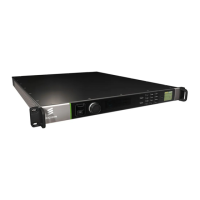• Handle modules carefully, holding them by edges or rear panels.
• Do not touch solder joints, pins, or exposed printed circuitry.
• Do not leave the modules where others can handle and possibly damage them.
• While the module is still in its anti-static package, touch it to an unpainted metal
part of the system unit for at least two seconds. (This drains static electricity
from the package and from your body).
• Remove the module from its package and install it directly into your base
chassis without setting it down. If it is necessary to set the module down, place it
in its static-protective package.
• Take additional care when handling modules during cold weather, because
heating reduces indoor humidity and increases static electricity.
7.10.3 Installing a New Module
A new module can be inserted when the unit is powered off or on. When inserted
and powered, the unit will determine the module capabilities and make it available
for configuration. Initially a default set of parameters will be in place. As long as
there are licenses available for the features required, the module can then be
configured and used immediately.
Caution!
To avoid damaging the module, always handle carefully (see section 7.10.1) and
avoid electrostatic discharge (see section 7.10.2
).
To install a new module:
1. Remove the blanking plate from the module slot in which the new module is to
be fitted.
2. Carefully remove the new module from its anti-static package, and insert it in to
the base unit, slotting the module edges in to the module guides.
3. Push the module home, so that the rear panel is flush with the rear of the base
unit.
4. Tighten the two captive retaining screws.
5. When the chassis detects a new card fitted, it will be displayed on the
Dashboard, and an alarm will be raised. If all options are reported correctly, the
Accept Hardware Configuration needs to be applied. This will accept the new
hardware configuration and clear the alarm.

